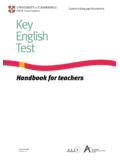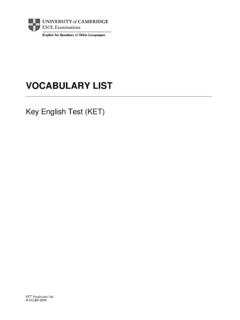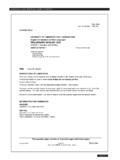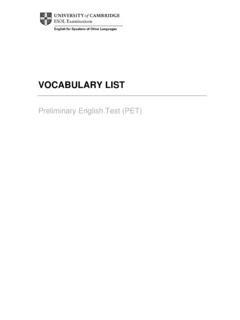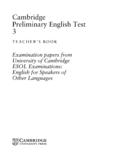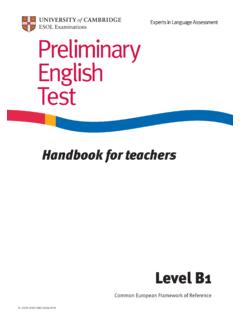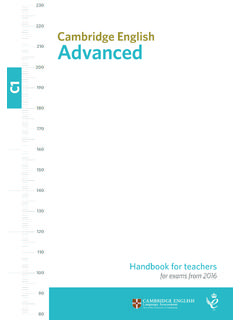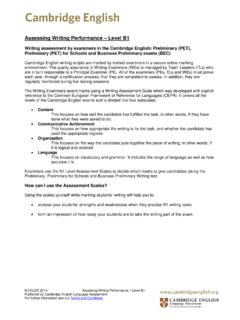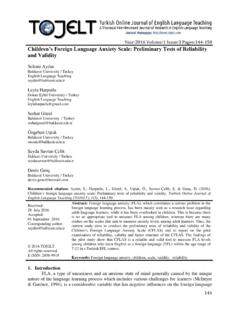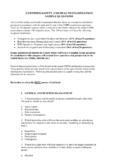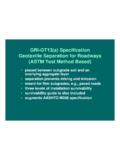Transcription of Contents
1 ContentsPreface 1 University of Cambridge ESOL Examinations ..1 Introduction to Cambridge ESOL ..1 The Association of Language Testers in Europe (ALTE) ..1 Key features of Cambridge ESOL Examinations ..2 The Production of Cambridge ESOL Question Papers ..2 The Cambridge ESOL Main Suite: A Five-Level System ..3 preliminary english Test (PET) ..3 Background ..3 The Level of PET ..3 PET Candidature ..3 What sort of test is PET ..4 Marking and Grading ..4 Administration ..4 Time and place ..4 Special Circumstances ..4 PET Support ..5 PET Content: an overview ..5 Aims and Objectives ..5 Reading ..5 Writing ..6 Listening ..6 Speaking ..6 Language Specifications ..6 Inventory of Functions, Notions and Communicative Tasks .6 Inventory of Grammatical Areas.
2 7 Topics ..8 Lexis ..8A Detailed Guide to PET ..9 Paper 1 Reading and Writing ..9 Preparing for the Reading Component .. 9 Preparing for the Writing Component ..11 Reading and Writing Sample Paper (1) ..13 Reading and Writing Sample Paper (2) ..21 Answer Key for Sample Test 1 ..28 Answer Key for Sample Test 2 ..29 Sample Scripts for Sample Paper 1 ..29 Sample Scripts for Sample Paper 2 ..31 Reading and Writing Candidate Answer Sheets ..33 Paper 2 Listening ..35 Preparing for the Listening Paper ..35 Listening Sample Paper (1) ..37 Listening Sample Paper (2) ..41 Answer Keys for Sample Papers 1 and 2 ..45 Listening Candidate Answer Sheet ..46 Listening Paper Tapescript (1) ..47 Listening Paper Tapescript (2) ..51 Paper 3 Speaking ..55 Preparing for the Speaking Test.
3 55 Cambridge Common Scale for Speaking ..58 Speaking Sample Paper ..59 Page iPage iiPage 1 PREFACEThis handbook is intended principally for teachers andcourse designers who are, or intend to become, involved inpreparing candidates for the Cambridge preliminary EnglishTest (PET). There are separate handbooks for other CambridgeESOL introductory part of the handbook provides a generalbackground to the Cambridge ESOL examinations and anoverview of the work of Cambridge ESOL, including adescription of current procedures for test design, productionand marking. It is hoped that this will be of interest both tothose who are familiar with the Cambridge ESOL examinations, and to those who are coming to them for thefirst further information on any of the Cambridge ESOL examinations, please contact:Cambridge ESOL Information1 Hills RoadCambridgeCB1 2 EUUnited KingdomTelephone: +44 1223 553355 Fax: +44 1223 460278email: OF CAMBRIDGE ESOLEXAMINATIONSI ntroduction to Cambridge ESOLU niversity of Cambridge ESOL Examinations (CambridgeESOL) is a part of the University of Cambridge LocalExaminations Syndicate (UCLES), which has providedexaminations in english for speakers of other languages since1913.
4 Cambridge ESOL offers an extensive range ofexaminations, certificates and diplomas for learners andteachers of english . In 2002 over million people tookthese examinations at centres in over 130 ESOL was formerly known as UCLES EFL. Thetitle ESOL english for Speakers of Other Languages wasadopted in October 2002, reflecting the increasing diversityof the ESOL examinations can be taken by anyonewhose first language is not english . They are suitable forlearners of all nationalities, whatever their first language andcultural background, and there are examinations suitable forlearners of almost any age. The range of Cambridge ESOL examinations includes specialist examinations in BusinessEnglish and english for Academic Purposes, as well as testsfor young learners and a suite of certificates and diplomas forlanguage examinations cover all four language skills listening,speaking, reading and writing.
5 They include a range of taskswhich assess candidates ability to use english , so that inpreparing for the examinations, candidates develop the skillsthey need to make practical use of the language in a varietyof contexts. Above all, what the Cambridge ESOL examinations assess is the ability to communicate effectivelyin ESOL is committed to providing examinations ofthe highest possible quality. This commitment is underpinnedby an extensive programme of research and evaluation, andby continuous monitoring of the marking and grading of allCambridge ESOL examinations. Of particular importance isthe rigorous set of procedures which are used in theproduction and pretesting of question papers, and these aredescribed in the following Association of Language Testers in Europe(ALTE)Cambridge ESOL is a member of the Association of LanguageTesters in Europe (ALTE), which was formed in 1990.
6 Themembers are all providers of language examinations andcertificates from countries within Europe. The principal objectives of ALTE are as follows: to promote the transnational recognition of certification,especially in Europe to establish common standards for all stages of thelanguage testing process, test development, questionand materials writing, test administration, marking andgrading, reporting of test results, test analysis andreporting of findings to collaborate on joint projects and in the exchange ofideas and ESOL examinations fulfil the Code of Practiceestablished by ALTE. This Code of Practice focuses on theresponsibilities of both examination providers andexamination users and covers four main areas: developing examinations interpreting examination results striving for fairness informing examination more information on ALTE please visit 2 Key features of Cambridge ESOL ExaminationsCambridge ESOL undertakes: to assess language skills at a range of levels, each of themhaving a clearly defined relevance to the needs oflanguage learners; to assess skills which are directly relevant to the range ofuses for which learners will need the language they havelearnt, and which cover the four language skills listening, speaking, reading and writing as well asknowledge of language structure and use.
7 To provide accurate and consistent assessment of eachlanguage skill at the appropriate level; to relate the examinations to the teaching curriculum insuch a way that they encourage positive learningexperiences and to seek to achieve a positive impactwherever possible; to endeavour to be fair to all candidates, whatever theirnational, ethnic and linguistic background, gender ESOL examinations are designed around fouressential qualities: validity, reliability, impact and is normally taken to be the extent to which a test canbe shown to produce scores which are an accurate reflectionof the candidate s true level of language skills. Reliabilityconcerns the extent to which test results are stable, consistentand accurate, and therefore the extent to which they can bedepended on for making decisions about the concerns the effects, beneficial or otherwise, whichan examination has on the candidates and other users,whether these are educational, social, economic or political,or various combinations of these.
8 Practicality can be definedas the extent to which an examination is practicable in termsof the resources needed to produce and administer it. Allthese factors underpin the development and production ofCambridge ESOL examinations, and have been taken intoconsideration in developing the updated PET examination Production of Cambridge ESOL Question PapersThe production process for question papers for CambridgeESOL examinations begins with the commissioning ofmaterial and ends with the printing of question papers. For the majority of Cambridge ESOL question papers thereare five main stages in the production process: commissioning editing pretesting analysis and banking of material question paper process is represented in the diagram on the ESOL employs teams of item writers to produceexamination material, and throughout the writing and editingprocess strict guidelines are followed in order to ensure thatthe materials conform to the test specifications.
9 Topics orcontexts of language use which might introduce a biasagainst any group of candidates of a particular background( on the basis of sex, ethnic origin, etc.) are selection and editing, the items are compiled intopretest papers. Pretesting plays a central role as it allows forquestions and materials with known measurementcharacteristics to be banked so that new versions of questionpapers can be produced as and when required. Thepretesting process helps to ensure that all versions conform tothe test requirements in terms of content and level pretest paper is supplied to candidates with anadditional anchor test. The anchor items are carefully chosenon the basis of their known measurement characteristics, andtheir inclusion means that all new items can be linked to acommon scale of papers are despatched to a wide variety of schoolsand colleges which have offered to administer the pretests toTrialconstruction TriallingreviewTriallingPre-editing and editingof materialPretest construction RevisionRejectionPretestingItem analysisMaterials Bank*Question paperconstruction*electronic bank for pretested materialsCommissioning of material for question papersABPage 3able to use english in their own or a foreign country incontact with native and non-native speakers of english forgeneral purposes as described a Threshold User can deal withThe text types which can be handled by the learner at thislevel include street signs and public notices, productpackaging, forms.
10 Posters, brochures, city guides andinstructions on how to do things, as well as informal lettersand newspaper and magazine texts such as articles, featuresand weather forecasts. The kinds of listening texts the learnerneeds to understand are announcements made at railwaystations and airports, traffic information given on the radio,public announcements made at sporting events or popconcerts and instructions given by police or customs this level, candidates need to be able to not only pick outfacts, but also to understand opinions, attitudes, moods a Threshold User can doLearners at this level, if travelling as tourists, can get all theinformation needed from a tourist information centre, as longas it is of a straightforward, non-specialised nature. Similarly,if taking part in a guided tour, they can understand the mainpoints of a commentary and ask questions in order to getmore information, as long as no specialised technicallanguage is needed.
